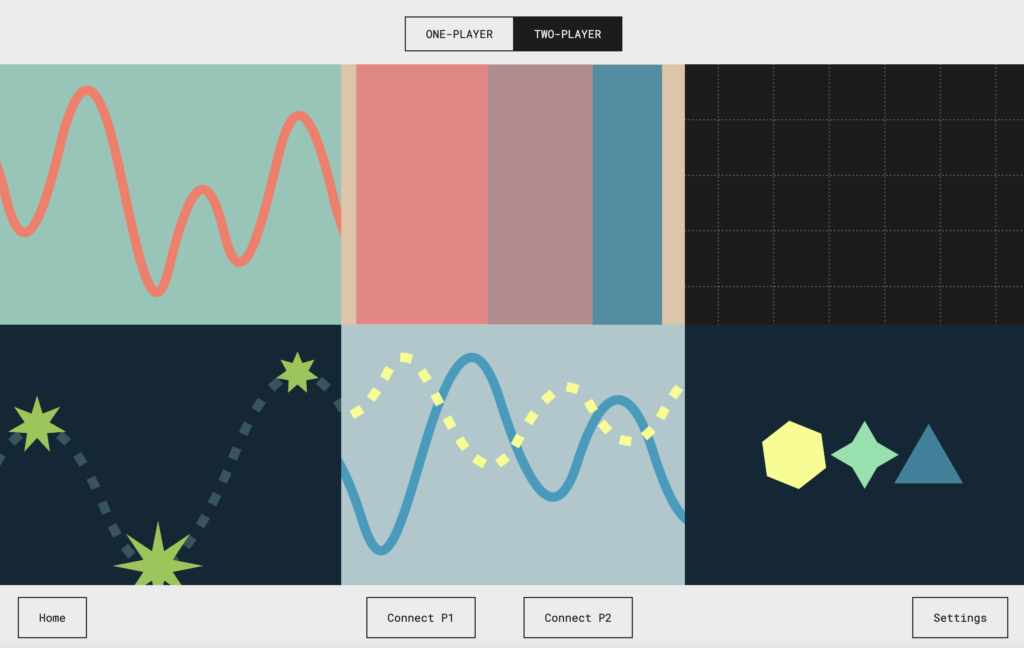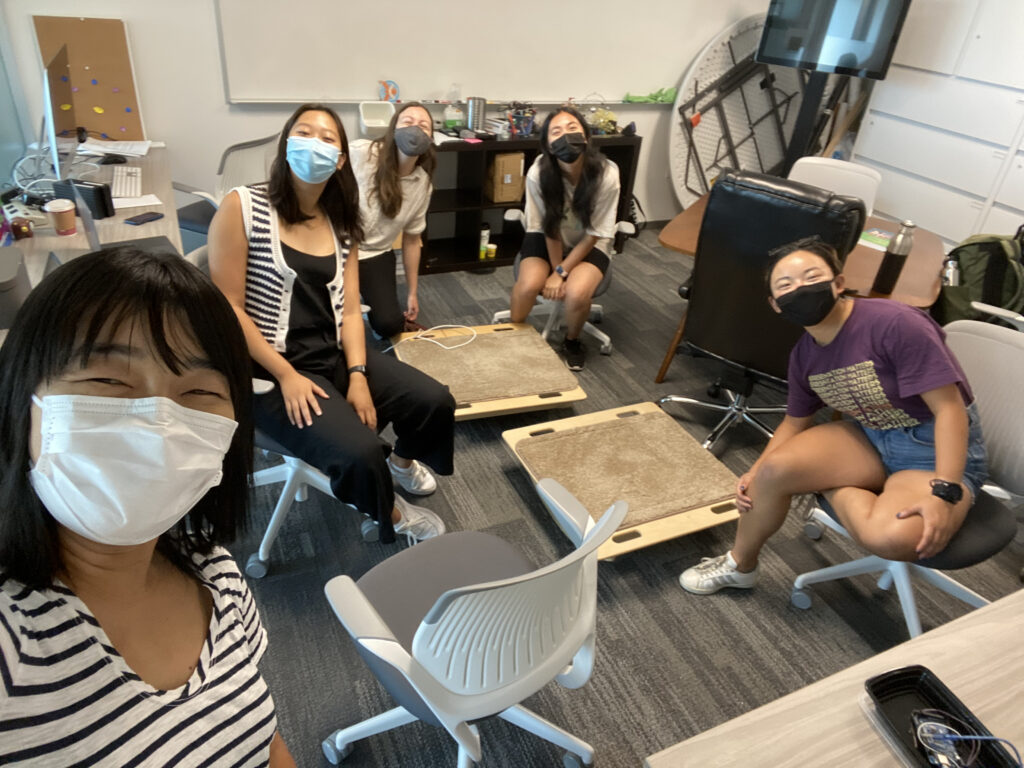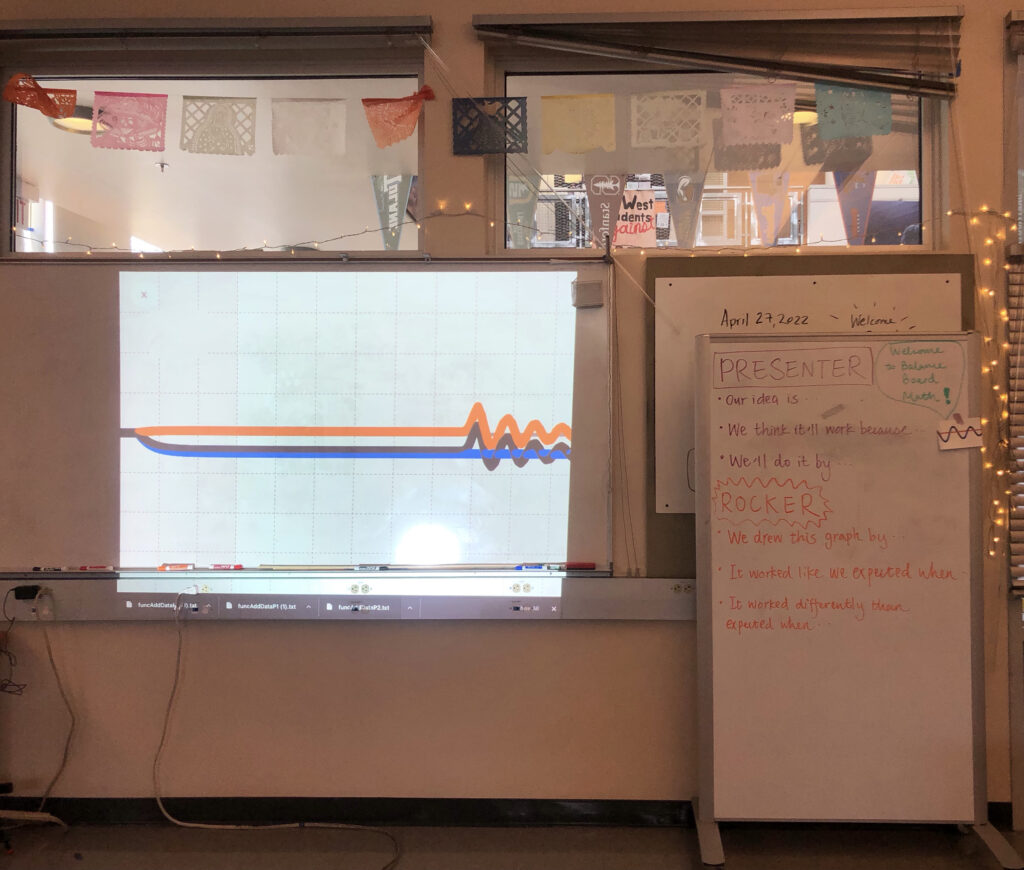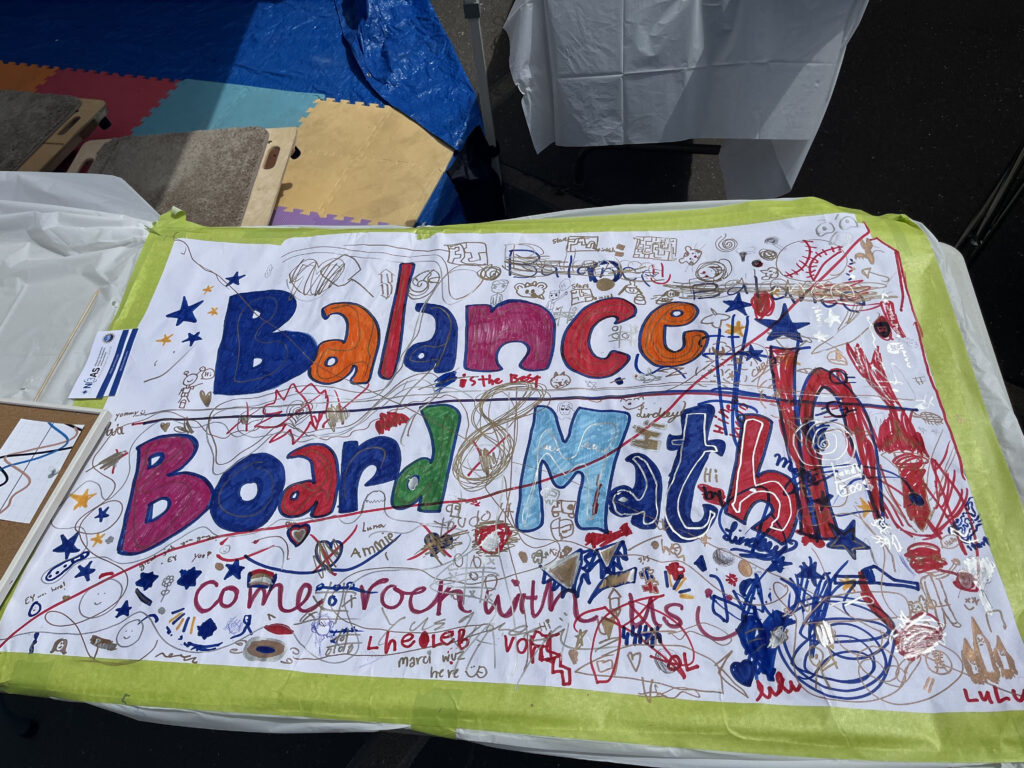Balance Board Math (BBM) aims to foster new forms of inclusive math pedagogy by incorporating learner’s experiences of balance. Learners rock on a wooden balance board to explore a range of mathematical concepts including functions, negative numbers and absolute value.
 Project team: Sofia Tancredi, Helen Li, Julia Wang, Carissa Yao, Genna Macfarlan, Yuqian Liu, Johnny Serrano, Kimiko Ryokai. This project is also part of the Special Education Embodied Design (SpEED) initiative.
Project team: Sofia Tancredi, Helen Li, Julia Wang, Carissa Yao, Genna Macfarlan, Yuqian Liu, Johnny Serrano, Kimiko Ryokai. This project is also part of the Special Education Embodied Design (SpEED) initiative.
Rationale
Some forms of movement, such as rocking, are common means of sensory self-regulation yet are discouraged in classroom contexts. This classroom conflict between self-regulation and student-regulation disproportionately affects sensory seekers: individuals who require high sensory stimulation through movement in order to regulate and attend. In parallel, recent developments in cognitive science suggest that moving in new ways forms the basis for conceptual learning (Varela et al., 1991), and the balance sensory system has been specifically implicated in cognitive development and conceptual reasoning (Antle et al., 2013; Hitier et al. 2014). As such, we seek to foster opportunities for the regulatory movement of rocking to serve as a resource for exploring mathematical concepts and representations.
Activities
Balance Graphing
Balance Graphing cultivates embodied understandings of graphical representations and function equations. Learners generate dynamic graphical displays by rocking on the balance board, “being the graph,” not just “seeing the graph” (Gerofsky, 2011). Balance Graphing activities present discovery-based challenges where children discover and control critical function parameters such as the frequency and amplitude of sinusoidal graphs.
Balance Number Line
The Balance Number Line introduces negative numbers and absolute value through balance experiences. Learners sit on a balance board and move their hands along a number line in front of them. The shifting weight of their hands controls the tilt of the board. In this context, negative numbers are the counterbalancing points to their positive counterparts. Learners solve movement problems such as figuring out how to move both hands while staying balance to plan, explore, and analyze relations on the number line.
Research-Practice Partnerships
BBM collaborates with partner teacher Elizabeth Dutton at Oakland Unified School District to explore BBM in the context of classroom practice. You can read about some of our work together in this research-practice brief.
BBM Tutorial
Want to experience BBM for yourself? Build your own sensor kit and connect a board to BBM activities with this tutorial written by Julia Wang.
Relevant Publications and Presentations
Tancredi, S. (2024). Balance Board Math: Exploring the sense of balance as a basis for functions and graphing and number line concepts. Digital Experiences in Mathematics Education, 10(2), 202-227. https://doi.org/10.1007/s40751-024-00140-1
Tancredi, S., & Abrahamson, D. (2024). Stimming as thinking: A critical reevaluation of self-stimulatory behavior as an epistemic resource for inclusive education. Educational Psychology Review, 36(3), 1–75. https://doi.org/10.1007/s10648-024-09904-y
Tancredi, S., Li, H.L., Wang J.X., Liu, Y., & Serrano Rodriguez, J. S. (to appear). Beyond ‘just sitting there’: Function addition through collaborative balance sensory activity with Balance Board Math (Poster presentation). AERA 2023, Chicago, IL.
Tancredi, S., Wang, J. X., Li, H. L., Yao, C. J., Macfarlan, G. L., & Ryokai, K. (2022). Balance Board Math: “Being the graph” through the sense of balance for embodied self-regulation and learning. In M. Horn, M. Giannakos, & T. Pontual (Eds.), Proceedings of IDC ’22: Interaction Design and Children (Vol. “Full papers”, pp. 137–149). https://doi.org/10.1145/3501712.3529743
Tancredi, S., Wang, J., Helen Tong Li, Yao, C. J., Ryokai, K., & Abrahamson, D. (2022). Graphing with Balance Board Math: Critical embodied design for regulation and learning. In C. Chinn, E. Tan, C. Chan, & Y. Kali (Eds.), “International collaboration toward educational innovation for all: Overarching research, development, and practices”—Proceedings of the 16th annual meeting of the Learning Sciences (ICLS 2022), Hiroshima, Japan (online) (pp. 1181-1184). ISLS.
Tancredi, S., Chen, R. S. Y., Krause, C., & Siu, Y.–T. (2022). The need for SpEED: Reimagining accessibility through Special Education Embodied Design. In S. L. Macrine & J.M. Fugate (Eds.), Movement matters: How embodied cognition informs teaching and learning. M.I.T. Press.
Tancredi, S., Wang, J., Li, H. T., & Yao, C. J. (2021, Dec 8). Balance Board Math: Rocking for regulation and learning.(Demo). Jacobs Institute Winter Design Showcase, Berkeley, CA.
Krause, C.M., Chen, R. S. Y., Tancredi, S., Cooper, B., Foley, E., Anton, J., Kim, J., & Abrahamson, D. (2021, October). Catching up with SpEED: Applying a framework for inclusive equitable learning opportunities through Special Education Embodied Design (Invited workshop). Unimc for Inclusion Settimana dell’inclusione (Inclusion Week), University of Macerata, Italy, October 25, 2021.
Krause, C.M., Chen, R. S. Y., Tancredi, S., Cooper, B., Foley, E., Anton, J., Kim, J., & Abrahamson, D. (2021, October). Catching up with SpEED: Applying a framework for inclusive equitable learning opportunities through Special Education Embodied Design (Invited colloquium talk). Graduate Group in Science and Mathematics Education (SESAME) Colloquium, University of California Berkeley, California, United States, October 21, 2021.
Tancredi, S., Chen, R. S. Y., & Krause, C. (2021, May 6-9). SpEEDing towards equitable instruction: Special Education Embodied Design for sensory diversity (Panel). Uncommon Senses III: Back to the Future of the Senses, Montreal, Canada.
Tancredi, S., Chen, R. S. Y., Krause, C., Abrahamson, D., & Gomez Paloma, F. (2021). Getting up to SpEED: Special Education Embodied Design for sensorially equitable inclusion. Education Sciences & Society – Open Access, 12(1), 114–136. https://doi.org/10.3280/ess1-2021oa11818
Tancredi, S., Chen, R. S. Y., Krause, C., & Abrahamson, D. (2021, March 16). Getting up to SpEED: Special education embodied design for sensorially equitable inclusion (Invited keynote). F. Gomez Paloma (Convener), Inclusion Week. University of Macerata, Italy. Excerpt.
Tancredi, S., Chen, R. S. Y., Krause, C. (2021, November 13). The Need for SpEED: Special Education Embodied Design (Invited Colloquium Talk). Graduate Group in Science and Mathematics Education (SESAME) Colloquium, Berkeley, California, United States.
Tancredi, S. (2020, October 9). The Balance Number Line: Incorporating vestibular activation into math instruction (Poster). STAR Sensory Symposium, Virtual Symposium.
Tancredi, S., Chen, R. S. Y., & Krause, C. (2020, February 2). The need for SpEED: Special education embodied design (Panel). UC-SpEDDR, Los Angeles, California.
Acknowledgments
Balance Board Math is supported by the Jacobs Institute Innovation Catalyst grant and the National Science Foundation Graduate Research Fellowship Program under Grant No. 1938055.








Comment to “Balance Board Math”